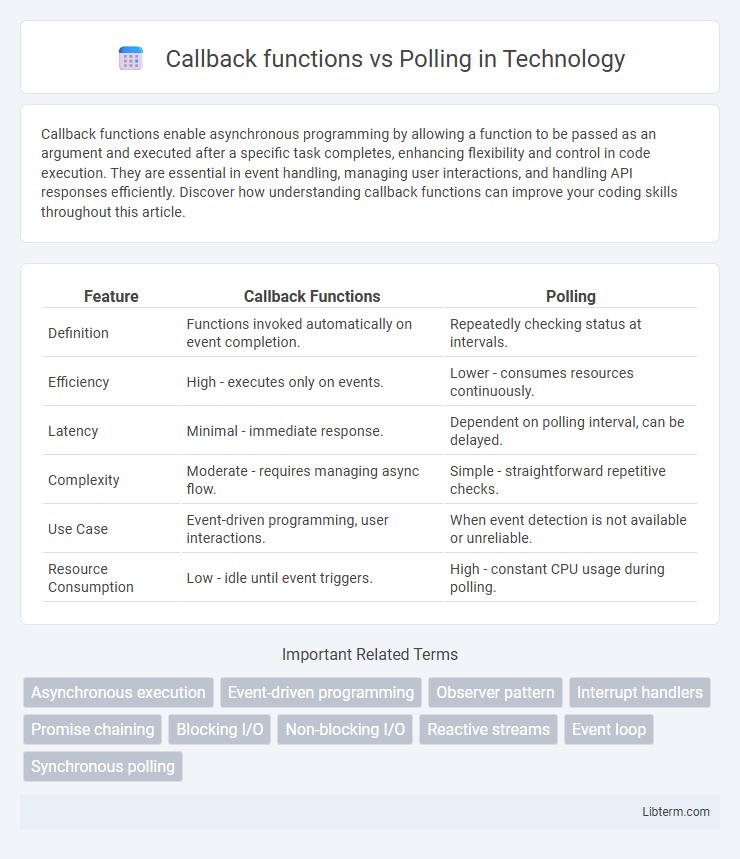Callback functions enable asynchronous programming by allowing a function to be passed as an argument and executed after a specific task completes, enhancing flexibility and control in code execution. They are essential in event handling, managing user interactions, and handling API responses efficiently. Discover how understanding callback functions can improve your coding skills throughout this article.
Table of Comparison
| Feature | Callback Functions | Polling |
|---|---|---|
| Definition | Functions invoked automatically on event completion. | Repeatedly checking status at intervals. |
| Efficiency | High - executes only on events. | Lower - consumes resources continuously. |
| Latency | Minimal - immediate response. | Dependent on polling interval, can be delayed. |
| Complexity | Moderate - requires managing async flow. | Simple - straightforward repetitive checks. |
| Use Case | Event-driven programming, user interactions. | When event detection is not available or unreliable. |
| Resource Consumption | Low - idle until event triggers. | High - constant CPU usage during polling. |
Introduction to Callback Functions and Polling
Callback functions enable asynchronous programming by allowing a function to be passed as an argument and executed once a specific event or operation completes, enhancing responsiveness and resource efficiency. Polling continuously checks a resource or condition at regular intervals, often leading to increased CPU usage and potential latency in response times. Comparing the two, callbacks offer event-driven execution, making them more efficient for handling asynchronous events than the repetitive, synchronous nature of polling.
Core Concepts: What Are Callback Functions?
Callback functions are blocks of code passed as arguments to other functions, executed only after a specific event or task completes, enabling asynchronous programming and efficient resource management. In contrast to polling, which continuously checks the status of an operation, callbacks reduce CPU usage by triggering actions precisely when needed. Understanding callbacks is essential for managing events, handling I/O operations, and designing responsive applications in languages like JavaScript, Python, and C++.
Core Concepts: Understanding Polling
Polling involves repeatedly checking the status of a resource or process at regular intervals to detect changes or completion, enabling a program to actively monitor an event without blocking execution. This approach contrasts with callback functions, where the program waits for a notification or response before proceeding. Polling can lead to increased CPU usage and potential delays in response time compared to event-driven callback mechanisms.
Key Differences Between Callbacks and Polling
Callbacks execute code automatically when an event occurs, allowing efficient resource usage by eliminating constant checks. Polling requires repeatedly querying the system or device at fixed intervals, which can lead to higher CPU usage and latency. The main difference lies in responsiveness: callbacks provide immediate reaction to events, while polling introduces delays dependent on the polling interval frequency.
Performance Comparison: Callback Functions vs Polling
Callback functions enhance performance by enabling asynchronous event handling, reducing CPU usage and latency compared to polling. Polling continuously checks the status of an event in fixed intervals, leading to higher processor overhead and slower response times under heavy loads. In real-time systems, callbacks optimize responsiveness and resource efficiency by triggering actions only when events occur, whereas polling wastes resources on unnecessary checks.
Use Cases: When to Use Callbacks
Callbacks are ideal for event-driven programs requiring immediate response, such as user interface interactions, asynchronous I/O operations, and real-time data processing. They efficiently handle scenarios where tasks depend on the completion of other tasks without blocking the main execution thread. Callbacks optimize resource utilization in network requests, file reading, and event handling, ensuring responsive and scalable applications.
Use Cases: When Polling Is Appropriate
Polling is appropriate in use cases where simplicity and low-frequency checks are sufficient, such as monitoring hardware status or checking user input at regular intervals. It suits scenarios where event-driven mechanisms are unavailable or too complex to implement, and the system can tolerate some delay in response time. Examples include embedded systems with limited resources and applications requiring periodic updates without urgent event handling.
Real-world Examples: Callback Functions in Action
Callback functions power event-driven frameworks like Node.js, enabling non-blocking I/O operations by triggering actions upon task completion, such as processing user input or handling database queries. In contrast, polling involves regularly checking the status of a resource, often seen in embedded systems or hardware communication, which can lead to inefficiency and increased CPU usage. For example, JavaScript uses callbacks extensively in asynchronous web APIs like fetch(), improving responsiveness by executing code only when data retrieval completes.
Real-world Examples: Polling Implementations
Polling implementations are commonly used in scenarios such as keyboard input detection in embedded systems, where the processor repeatedly checks the status of input devices at regular intervals. Another real-world example is network monitoring tools that continuously request status updates from servers to detect outages or performance issues. Printer status checking in office environments also employs polling, as the computer periodically queries the printer to confirm readiness or error conditions.
Choosing the Right Approach for Your Application
Callback functions provide efficient event-driven execution by triggering actions immediately when data is available, reducing CPU usage and latency. Polling continuously checks for status updates at regular intervals, which can be simpler to implement but may increase resource consumption and introduce delays. Selecting the right approach depends on application requirements for responsiveness, resource constraints, and complexity, with callbacks favored in real-time scenarios and polling suited for periodic or less time-sensitive tasks.
Callback functions Infographic

 libterm.com
libterm.com